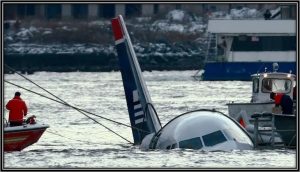This Day in Aviation History–The Miracle on The Hudson
Contributor: Barry Fetzer
Sources: History.com

Photo Credit: Chris McGrath/Getty Images
If you’ve ever hit a bird (or another animal) while flying (or driving) raise your hand. No hands?
I was in a drive-through lane of a fast-food restaurant one day in Jacksonville, NC and noted in my rear-view mirror that the lady behind me had an animal in the grill of her car. I stopped and got out and mentioned to her that she had a furry critter blocking the airflow through her radiator and asked if she wanted me to remove the expired animal, as it happened, a fox. She did and I did and I tossed the carcass of the poor fox into a wooded area next to the restaurant. As I think back, I should have used my trusty pocket knife and saved the tail of that fox (like the rabbit’s foot I wore chained to my military leather flight jacket for years) for luck. But I didn’t. Oh well. Coulda-shoulda.
So, it (“it” being unintended strikes with animals) happens on the ground and in the air. Of course, such an occurrence in the air is a much bigger cause of concern then the same thing happening on the ground.
I hit a pelican one time flying a USMC helicopter and was splattered through the broken wind screen by pelican blood and guts (thankfully I had my helmet’s visor down) and had to wipe off the visor, windshield wiper-like, with my flight-gloved left hand to see what I was doing to return to MCAS New River and land the aircraft. But all’s well that ends well. Same with “the Miracle on the Hudson” (as the event was coined) on this day in aviation history in 2009.
According to the History.com editors and retrieved today from https://www.history.com/this-day-in-history/sully-sullenberger-performs-miracle-on-the-hudson?cmpid=email-hist-tdih-2025-0115%7C-01152025&om_rid=, on January 15, 2009, “a potential disaster turns into a heroic display of skill and composure when Captain Chesley Burnett Sullenberger, III safely lands the plane he was piloting on New York City’s Hudson River after a bird strike caused its engines to fail. David Paterson, governor of New York at the time, dubbed the incident the ‘miracle on the Hudson.’
“Sullenberger, a former fighter pilot with decades of flying experience, received a slew of honors for his actions, including an invitation to Barack Obama’s presidential inauguration and resolutions of praise from the U.S. Congress.
“About a minute after taking off from New York’s La Guardia Airport on January 15, 2009, US Airways Flight 1549 collided with one of the aviation industry’s most threatening foes: a flock of geese. Crippled by the bird strike, both engines lost power and went quiet, forcing Captain Sullenberger to make an emergency landing. When air traffic controllers instructed the seasoned pilot to head for nearby Teterboro Airport, he calmly informed them that he was ‘unable’ to reach a runway. ‘We’re gonna be in the Hudson,’ he said simply, and then told the 150 terrified passengers and five crew members on board to brace for impact.
“Ninety seconds later, Sullenberger glided the Airbus A320 over the George Washington Bridge and onto the chilly surface of the Hudson River, where it splashed down midway between Manhattan and New Jersey. As flight attendants ushered passengers into life jackets, through emergency exits and onto the waterlogged wings of the bobbing jet, a flotilla of commuter ferries, sightseeing boats and rescue vessels hastened to the scene. One survivor suffered two broken legs and others were treated for minor injuries or hypothermia, but no fatalities occurred. After walking up and down the aisle twice to ensure a complete evacuation, Sullenberger was the last to leave the sinking plane.
“In October 2009, the now-famous pilot, known to his friends as ‘Sully,’ published a book about his childhood, military background and career entitled ‘Highest Duty: My Search for What Really Matters.’ He retired from US Airways after 30 years in the airline industry on March 3, 2010, and has since devoted his time to consulting, public speaking and advocating for aviation safety.”
Onward and upward!
Sources: History.com, Getty Images.







